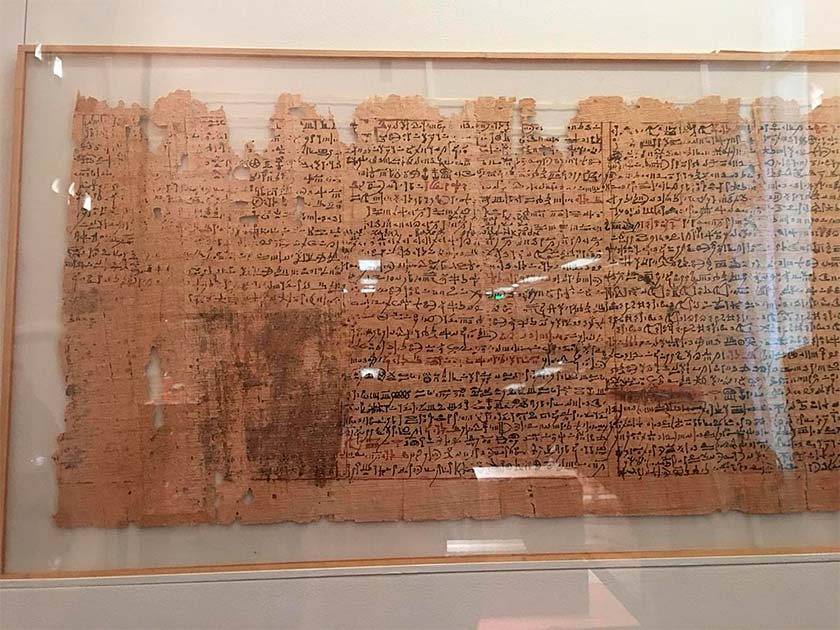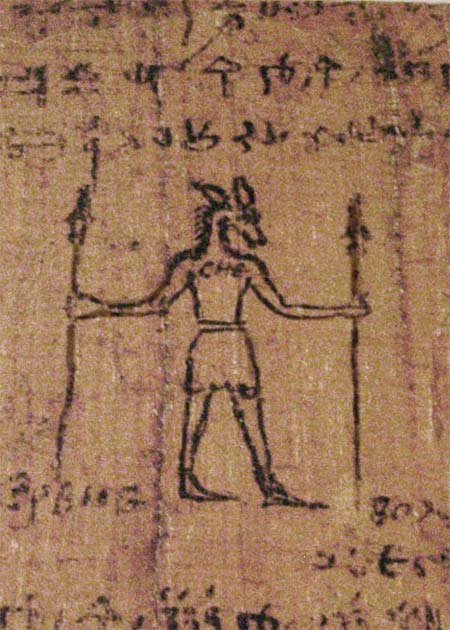Many notable papyri from Ancient Egypt provide a look into what life was like back then. There are papyri full of medical writings, scientific writings, funerary-related rituals and Books of the Dead, official records, and myths.
There is the Edwin Smith Papyrus, the Ebers Papyrus, the Turin King List, and the London Medical Papyrus. And then there are the ones that teach you magic, like the Greek Magical Papyri. This ancient book of spells and rituals provides readers with magical knowledge and illustrates the syncretism prevalent in Graeco-Roman Egypt.
The Greek Magical Papyri
The Greek Magical Papyri (Papyri Graecae Magicae) is a collection of papyri from ancient Graeco-Roman Egypt. The work is primarily written in ancient Greek, but sections are written in Demotic and Old Coptic.
The pages of the papyri contain lists of rituals, magic spells, hymns, and formulae that date between 100 BC to 400 AD. One of the most known texts from the Greek Magical Papyri is the “Mithras Liturgy.”
The Mithras Liturgy is the invocation of the god Helios Mithras, who is said to reveal the secrets of immortality to the individual performing the ritual. The Mithras break down seven stages the soul must ascend through before immortality is revealed.

But the Greek Magical Papyri is not a single tome from deep within an ancient archive; instead, it is a series of individual texts divided into volumes. Each volume of the Greek Magical Papyri includes multiple spells, rituals, and ancient formulae.
- Practical Magic: The Summoning Spells of The Book of Abramelin
- Enochian: John Dee, Magic, and the Language of God
There is much mystery surrounding the text because the reason why these lists of spells and rituals were created over several centuries is unknown to us today. Some scholars believe that the Greek Magical Papyri is a piece of “underground literature” that was hidden away during a time when magical texts were being burnt at the start of Christian book burnings. Other scholars believe the Greek Magical Papyri are pieces of text created by Egyptian priests from the third or fourth centuries, not some underground secret text.
We first learned about the existence of the Greek Magical Papyri at the beginning of the 19th century when it was listed on the art market in Egypt as part of the sale of antiquities. Another section of papyri was obtained by French diplomat Jean-Francois Mimaut and was kept in the French Bibliotheque Nationale.

The bulk of the Greek Magical Papyri is known as the Anastasi collection. In 1827 a man who went by the name Kean d’Anastasi purchased several papyri. d’Anastasi claimed that he got the papyri while in Thebes (or modern Luxor today) and then sold the sections off to European collectors and institutions like Rijksmuseum van Oudheden in the Netherlands, the Staatliche Museen zu Berlin in Germany, the Louvre in France and the British Museum in England.
The content of the Greek Magical Papyri shows the melding of Egyptian magic with Greco-Roman ritual worship. There is also a large amount of syncretism in the papyri, which shows the mingling and mixing of Greek, Egyptian, and Jewish beliefs and ritual magic.
The Greek Magical Papyri includes sections in Demotic and Coptic languages which were stages of the ancient Egyptian language that used hieratic script (cursive rather than pictorial hieroglyphics) and the incorporation of the Greek alphabet and supplemental letters that the Egyptian language borrowed from the Greek language. The Rosetta Stone, discovered in 1799, is written in three scripts: Demotic, the Greek alphabet, and Egyptian hieroglyphs.
The Greek Magical Papyri shows the evolution, influence, and shifts to language occurring in Graeco-Roman Egypt. The text is written in forms of language that could be used by both Greeks and Egyptian healers, ritualists, or mystics. Practical, indeed.
Yes but the Spells?
Like all good grimoires, the Greek Magical Papyri contains many different spells and rituals one can perform, as well as the necessary ingredients required to cast the spells. One spell, known as the “indispensable invisibility spell,” requires some interesting ingredients.
First, you need some fat. Don’t worry if this is tricky, as you can substitute the eye of a nightowl, and then add to these a ball of dung rolled by a beetle, and the oil of an unripe olive. The spell caster is instructed to grind the ingredients until smooth, then apply the paste to the entire body and “say to Helios: ‘I adjure you by your great name, make me invisible, lord Helios/in the presence of any man until sunset.’”
- The Book of Shadows: Is There a Secret Witches’ Spellbook?
- The Edwin Smith Papyrus: Practical Egyptian Medicine
If that spell didn’t work (can you imagine…?), there is another spell that is known as a “tested spell of invisibility” and this one is described as being a great work. All you will need is “the eye of an ape or of a corpse that has died a violent death and a plant of peony. Rub these with oil of lily from right to left on the face” while invoking the gods Anubis and Osiris for the gift of invisibility.
The Greek Magical Papyri says that after reciting the spell and rubbing just your face with the concoction, you will be invisible for as long as you want. Sadly no notes survive which attest to the efficacy of this spell, however. Or the others.

Many of the spells in the Greek Magical Papyri are incredibly long and very complex. For a spell that is called the “powerful spell of the Bear, which accomplishes anything,” one must “take the fat of a black ass, the fat of a dappled she-goat, the fat of a black bull, and Ethiopian cumin, mix it all together and make an offering to the Bear, having as a phylactery (an amulet box common in Judaism) hairs from the same animals which you have plaited into a cord and are wearing as a diadem around your head. Anoint your lips with the fats, smear your whole body with storax oil (a natural resin derived from the damaged bark of the Liquidambar orientalis Mill plant), and make your petition while holding a single-shooted Egyptian onion. Gird yourself with a palm fiber of a male date palm, kneel down, and speak.”
This long formula is listed in full in the text. The mention of a bear in this spell exemplifies the mixing of Egyptian and Greek knowledge. Ancient Greeks have described bears, but they are not one of the many animals worshiped as part of the Egyptian pantheon, mostly because Ancient Egypt isn’t known for its massive populations of bears. Or bears at all.
Some spells in the Greek Magical Papyri are for medicinal treatment of the ill. There are spells for treating swollen testicles, a cough, migraines, dog bites, removal of poisons, and the spell for removing a bone stuck in the throat.
Other spells are more entertaining than anything. In the Greek Magical Papyri, there are many love spells, spells for attraction, spells to make a woman confess the name of the man she loves, etc. There are spells for “subjugation concerning the mole-[rat],” “cat ritual for many purposes,” “request for a dream oracle,” and a number of spells to cause “evil sleep.”
Top Image: The Greek Magical Papyri contained all sorts of spells for every day tasks. Source: Gasia / Adobe Stock.